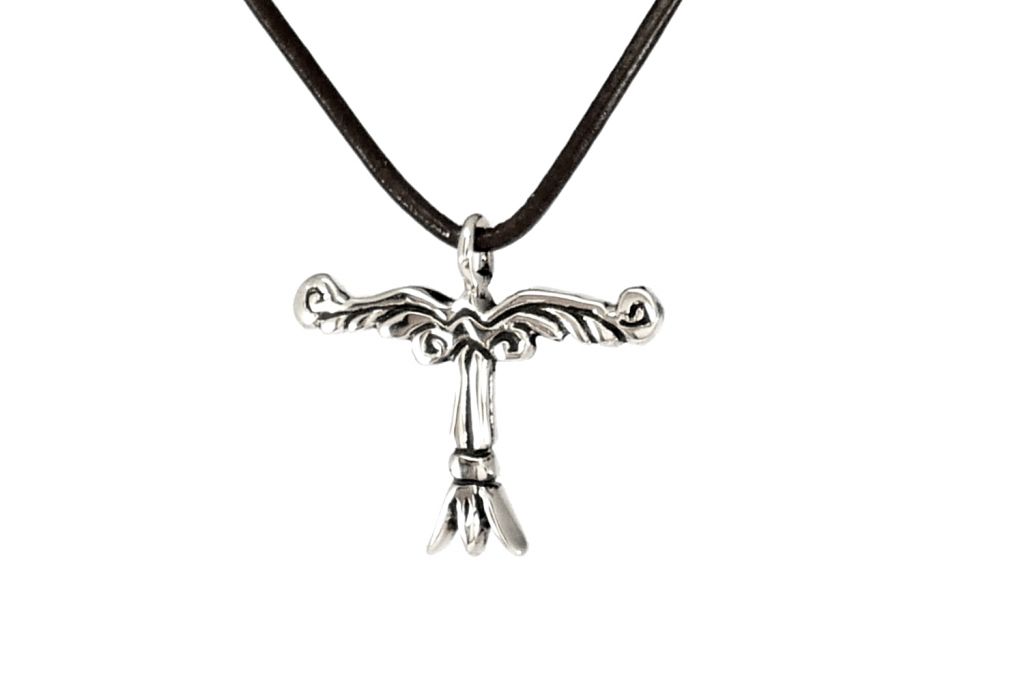Small Irminsul Pendant, Silver
Pendant of the irminsul, a cultic pillar in shape of a tree, as depicted at a relief at the rock formation of the Externsteine, Germany
Irminsul
Size of the Irminsul pendant approx. 28 x 25mm, handmade from solid 925 silver. Supplied with leather thong and certificate.
It took Charlemagne over thirty years to begin integrating the Saxon tribes into his Frankish empire from 772. Under the pretext of Christianising the pagan Saxons, power-political interests were enforced with the sword. During two major campaigns, Charles destroyed the great central sanctuary of the Saxons, the "world column" Irminsul, near Eresburg (Obermarsberg).
However, the Saxons resisted in the years to come under the leadership of Prince Widukind and devastatingly defeated the Frankish army at the Süntel. Charles' missionaries, who were already spreading the Christian faith near the Lower Weser river, were also slain.
Charlemagne's counterattack ended with the "Blood Court of Verden", which is reported in the Einhard Annals and the Imperial Annals from the Lorsch Monastery. Over 4500 rebellious Saxon warriors and nobles are said to have been executed as a deterrent. Widukind, who had fled to Denmark, later returned and adopted the Christian faith.
The origin of the Irminsul is possibly to be seen in the cultic worship of the world tree Yggdrasil, which plays a central role in Germanic mythology. Irmin, Tiu to the Scandinavians, was a son of Wotan (Odin). As god of war and protector of the Thing, the assembly of all free men, he experienced great veneration.
Irminsul - Our pendant
What the central sanctuary of the Germanic Saxons, the Irminsul, looked like remains an open question. The trail leads to another site that is still a centre of attraction for many Germanic enthusiasts today. While archaeologists shrug their shoulders and point out that the earliest finds date back to the High Middle Ages, the Externsteine to the west of Horn-Bad Meinberg remain an ancient cult site of pagan Germanic prehistory to common opinion.
Independently of this, remains of an old hermitage can be found in the rock of the Externsteine. From the 11th century onwards, Christian monks began to carve living and prayer grottos into the rock. A huge rock relief, 5.50 m high, also dates from this time. It shows the descent of Christ from the cross with several figures, a dragon and a bent tree, possibly a date palm (picture). Therefore, it is rather unlikely that there is actually a contextual reference to the Irminsul here.
The interpretation of the depiction of the bent tree as a Christian triumph over paganism was largely adopted without criticism. The tree was interpreted as a bent Irminsul and the dragon as a world serpent, the symbol of earth forces.
Even though the actual appearance of the Irminsul is unknown and the motif of the Externsteine has no relation to the Irminsul, this representation is still very popular today and is considered a symbol of the Germanic religion itself, especially among followers of Asatru.
Irminsul - Unser Anhänger
Wie das zentrale Heiligtum der germanischen Sachsen, die Irminsul, ausgesehen hat, bleibt eine offene Frage. Der Weg führt zu einem anderen Ort, der bis heute Anziehungspunkt vieler Germanenfreunde ist. Während die Archäologen schulterzuckend darauf hinweisen, dass die frühesten Funde und Befunde aus dem hohen Mittelalter stammen, bleiben die Externsteine westlich von Horn-Bad Meinberg in der Populärwissenschaft doch stets ein alter Kultplatz der heidnischen germanischen Vorzeit.
Davon unabhängig finden sich im Fels der Externsteine Reste einer alten Einsiedelei. Ab dem 11. Jahrhundert begannen christliche Mönche, Wohn- und Gebetsgrotten in den Fels zu schlagen. Aus dieser Zeit stammt auch ein gewaltiges Felsrelief, das eine Höhe von 5,50m aufweist. Es zeigt die Kreuzabnahme Christi mit mehreren Figuren, einem Drachen und einem geknickten Baum, möglicherweise einer Dattelpalme (Bild). Daher ist es eher unwahrscheinlich, dass hier tatsächlich ein inhaltlicher Bezug zur Irminsul besteht.
Die Interpretation der Darstellung des geknickten Baumes als christlicher Triumph über das Heidentum wurde weitgehend ohne Kritik übernommen. Der Baum wurde als geknickte Irminsul und der Drache als Weltenschlange, das Symbol der Erdkräfte, gedeutet.
Auch wenn das tatsächliche Aussehen der Irminsul unbekannt ist und das Motiv der Externsteine keinen Bezug zur Irminsul hat, ist diese Darstellung heute noch sehr beliebt und gilt vor allem unter Anhängern des Asatru als ein Symbol für die germanische Religion an sich.
| Delivery time | 1-2 weeks |
|---|---|
| weight | 0.004000 |
| size | 28 x 25 mm |
| Era | Germans |
| Material | Silver 925 |
| Kind of replica | Pendants |
| scope of delivery | Delivery in a jewellery case with leather necklace and certificate |

